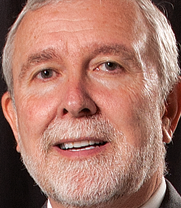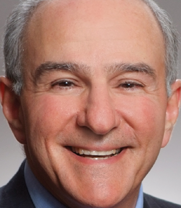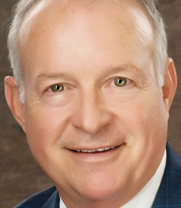Industry CEOs Cautiously Optimistic Heading Into Second Half of Year
"The additional competition and the struggling economy make it hard to grow sales.” — Neil Berube, president and CEO of Associated Food Stores "It is still a very slow-growth situation." — Mike Needler Sr., chairman and CEO, Fresh Encounter “Our customers are continuing to grow share in their respective markets." — Jay Campbell, president and CEO, AG of Baton Rouge
Food retailers and wholesalers around the country have seen uneven results in the first half of the year, but for the most part are confident that their sales will continue to improve, or at least remain even as the economy lurches ahead.
In interviews last week with SN editors, operators cited a lack of food inflation as one factor inhibiting sales growth, and some also cited the impact of the payroll tax reinstatement on low-income shoppers.
“I think when January hit and everybody got a pay cut as a result of the payroll taxes, we saw a downward trend though March and into April,” said Bill White, chief executive officer, Belle Foods, Birmingham, Ala. “It picked up a little again in May and June, but it took people a while to get used to not having so much money.”
Regional variations in the economy also were evident in the executives’ remarks, as some areas — such as Ohio and southern Louisiana — have seen gains in employment.
Several companies cited increasing competition in their markets, from chains like Costco Wholesale Corp., Wal-Mart Stores and Kroger Co.
Many of the operators interviewed by SN are expanding their businesses or considering expansions, they said, and rolling out new marketing initiatives in the second half. Lubbock, Texas-based United Supermarkets, for example, is building three new stores in the second half of the year, and rolling out a new “customer communications” initiative in connection with its newly introduced logo.
Following are comments from the industry executives interviewed by SN:
Neil Berube, Associated Food Stores
Neil Berube, president and CEO of Associated Food Stores, Salt Lake City, said the member-owned cooperative had “a little better expectations” going into the first half but ended up with flat sales.
“We budgeted for member stores to be slightly up and for corporate-owned stores to be slightly down, but we ended up flat overall,” he told SN.

Neil Berube
Flat sales resulted from increasing competition, Berube said, including a new Costco “that is practically in the parking lot of our highest-volume store and a Wal-Mart in the middle of four corporate stores. In addition, Kroger continues to instigate new lower pricing. So competition stiffened and the economy remained unchanged, and that left us with flat sales for the first half and the likelihood of the same in the second half.
“We continue to see very little food inflation, so we’re not getting any revenue growth from that, and the additional competition and the struggling economy make it hard to grow sales.”
Berube mentioned two initiatives that will be key during the second half.
“First, we will be looking at expanding digital marketing and trying to grow sales through direct-to-the-consumer marketing. We’ve been testing a customer rewards program based on loyalty since last summer at a handful of corporate and member stores, and in the early fall we plan to roll the program out to the rest of our operators.
“Second, we’re transitioning to a hybrid EDLP pricing model. We’ve tested the program at the [11-store] Macey’s chain over the last six months, and now we plan to install that model in our corporate stores and offer it as an option to members. We’ve been an extreme high-low operator, but we feel that won’t take us into the future. We need to be more competitively priced on an everyday basis.”
Jim Denges, Central Grocers
Jim Denges, CEO of cooperative wholesaler Central Grocers, Joliet, Ill., said same-store sales were flat to slightly negative among its members in the first half of the year, but overall sales were up as a result of new business. Central’s co-op includes around 500 stores, including 39 Strack & Van Til corporately owned supermarkets.
Follow @SN_News for updates throughout the day.
“We’re facing a lot of new competition, and when new stores open, it doesn’t help us,” Denges told SN. He said several store remodelings and new stores could help sales in the second half but he is also watching to see how the newly freed Jewel-Osco performs. That banner, a leader in Central’s market, had struggled under Supervalu but could find new momentum behind a sharper local focus, and pressure from a Wal-Mart pricing campaign could trigger price investments throughout the market, Denges said.
“We have an interesting push going on now in our market from Jewel. They have opened an office here in the market where they haven’t had one in a long time, and that will probably be a positive for them,” Denges said. “They are also the recipient of a Wal-Mart campaign on price and it will be interesting to see how they respond to that.”
Scott Karns, Karns Quality Foods
Scott Karns, CEO, Karns Quality Foods, Mechanicsburg, Pa., said overall sales were up in the first half thanks to a new location. Same-store sales were also higher, but not at the level he anticipated as consumers balked at higher prices at the meat case.
“Our sales are up year-to-date as a company but we expected a little more in terms of same-store sales,” Karns said. “We came up a little shorter than we expected mainly on the meat side, with protein price increases keeping people from buying as much as they might. People were still buying items, but in smaller quantities and packages.”
Karns said he was “cautiously optimistic” that the company could reach a goal of 2% to 3% same-store sales increases in the second half, primarily as a result of marketing to existing customers through the chain’s loyalty rewards program. “We’re trying to increase baskets from our existing customers a little more than finding new shoppers,” he said.
Jay Campbell, AG of Baton Rouge
Jay Campbell, president and CEO, Associated Grocers of Baton Rouge, La., said gains in the chemical industry in southern Louisiana have helped drive economic growth and improved employment in that region.

Jay Campbell
He said his company enjoyed same-store sales increases in both dollars and units for product sold to its retail customers in the most recent fiscal year, which ended in May — the ninth out of the last 10 years in which the wholesaler has achieved such gains.
“Our customers are continuing to grow share in their respective markets,” he said.
Low prices for natural gas — and forecasts that prices will remain low for the next 10 years — are helping drive the local petrochemical industry, he explained.
“There will be lots of expansion on the waterfront for the next several years,” he said. “Housing has picked up considerably, so housing construction has picked up, and more sales of housing.”
He noted, however, that the region is still a relatively low-income area overall, and the company’s retailers are focusing on targeted, short-term promotions.
Many retailers are expanding, however, with additions, remodels and new-store construction.
“That shows a tremendously optimistic view from the retailers’ perspective,” he said.
Mike Needler Sr., Fresh Encounter
Mike Needler Sr., chairman and CEO, Fresh Encounter, Findlay, Ohio, said sales for the first half of the year have been “fairly on target.”

Mike Needler Sr.
As the economy seems to be slowly and surely improving, we are sensing that on the top line,” he said.
He noted that local unemployment had declined “considerably” since a year ago, and said he expected that to help drive sales at the 31-store operator.
However, “It is still a very slow-growth situation,” he cautioned.
The company added one new store in May — an acquisition of an independent in Indian Lake, Ohio — and Needler said the company could add one or two more stores to its portfolio in the next few months.
“We keep an eye out for acquisitions,” he said.
Bill White, Belle Foods
Bill White, CEO of Belle Foods, Birmingham, Ala., said sales were slow particularly through April as consumers adjusted to the 2% increase in payroll taxes enacted in January. This effect was particularly acute for stores in lower-income areas, he noted.
Join SN's LinkedIn Group to network with industry professionals.
“Overall sales this year are down versus our expectations,” White told SN. “We’re in some unique markets where there’s just not a lot of money — low income, a lot of people on food stamps. And I think when January hit and everybody got a pay cut as a result of the payroll taxes, I think we certainly saw a downward trend though March and into April. It picked up a little again in May and June, but it took people a while to get used to not having so much money. They are not going to cut back on gas because they still have to go to work, so they cut back on food. They’re buying cheaper proteins and more on private label. They’ve only got so much money.”
White said he was optimistic that customers have adjusted to the new realities and that the rebound experienced in May and June can be sustainable for the remainder of the year. “For the second half if [same-store sales] are up a couple percent, I’d be happy. One or two percent would be good, because it hasn’t been that good for the first six months.”
Robert Taylor, United Supermarkets
Robert Taylor, CEO of United Supermarkets, Lubbock, Texas, said sales during the first half met the company’s projected expectations. He said sales were positively impacted by reduced cost of goods; better shrink control; and an improved sales mix. However, sales were negatively impacted by health costs, fuel costs and increased competition from new channels, he added.
Looking ahead to the second half, Taylor said, “We expect the same positive rate of growth, with influences from the same factors as in the first half, along with the unknown impact of health care reform.”
According to Taylor, initiatives planned for the second half include launching a remodeling program that will begin with three stores this year; completing the construction of three new stores (one United Supermarket, one Market Street and one United Express convenience store); installing consumer-assisted ordering; and continuing its shrink-control program. In addition, he said the company plans “a guest-facing communication initiative.”
The communication initiative is part of the chain’s rebranding strategy that has already encompassed introduction of a new logo and will continue with evaluations and, when necessary, redesigns of in-store signage, including shelf tags.
Michael Burgoine, AG-New England
Michael Burgoine, president and CEO of Associated Grocers-New England, said overall sales in the first half were up slightly, “but not at the level we expected. They were pretty much flat. When we do our projections, there are a lot of ups and downs and sales patterns are erratic, partly due to weather differences from year to year. Last year we had a snowless winter and a hot spring and summer, whereas this year we had a more normal weather pattern in the winter, and that change distorted our projections.”
For the second half the member-owned cooperative is expecting “more of the same,” Burgoine said. “A lot of what happens will be weather-related. Many of our members rely on tourist business in the summer, and without a good summer, we’ll lose a lot of tourist business. But hopefully members will acquire some stores so we can capture additional business.”
In terms of second-half initiatives, Burgoine said AGNE is contemplating an expansion of its distribution center to 450,000 square feet from 380,000 square feet. “We’ve done the due diligence and a feasibility study, and we’ll present a proposal to our board in the fall. If the board approves the plan, we’ll start construction in the spring and plan to open by the fall of 2014.
"However, with the economy the way it is, there is some apprehension about expanding the warehouse, but we need to do it. Even though the facility is only seven years old, we’ve already outgrown it.”
If the company does expand the warehouse, it expects to consider adding more natural and organic foods to its mix, Burgoine said. “We’re also looking at adding automation to the warehouse, which we haven’t had before,” he added.
Jack Brown, Stater Bros. Markets
Jack Brown, chairman and CEO of Stater Bros. Markets, San Bernardino, Calif., said first-half sales were “right where we expected them to be.” They were up, and so were customer counts, “which continued to run strong as a reflection of our marketing programs, which are geared to what our customers and other customers are looking for. We’re keeping margins low and passing the savings to our customers.”
Brown said he expects sales to be “right on projection” during the second half, with increases continuing. He declined to be specific.

Jack Brown
During the second half, Stater will continue to do what it calls “dollhouse remodels” — upgrades to stores that can’t be expanded in size. “We take out the cross aisles and essentially remodel the whole store. As a result, customers who shop there like the idea that we’re fixing up ‘their’ store, and consumers who stop in not knowing what to expect really like what we’re doing,” he explained.
Stater acquired a 46,000-square-foot Ralphs in Moreno Valley, Calif., at the end of June, “and though that store won’t operate as a Stater for a while, it’s a good morale booster for the company because people know it will lead to a dozen or so promotions within the company, and that’s a good thing in this economic environment where there aren’t a lot of opportunities for people to get promotions.”
In terms of second-half initiatives, Brown said Stater “will be preparing for any new competition that may or may not enter the market. We always try to be prepared, and we’re always looking at any companies that may be coming in in terms of size, offering and pricing structure, to be sure we maintain our low-price leadership.” Though he did not specify what new competitors might be entering the area, local reports indicate Aldi is preparing to come into the Inland Empire and Wal-Mart plans to continue to add Neighborhood Markets there.
About the Authors
You May Also Like










